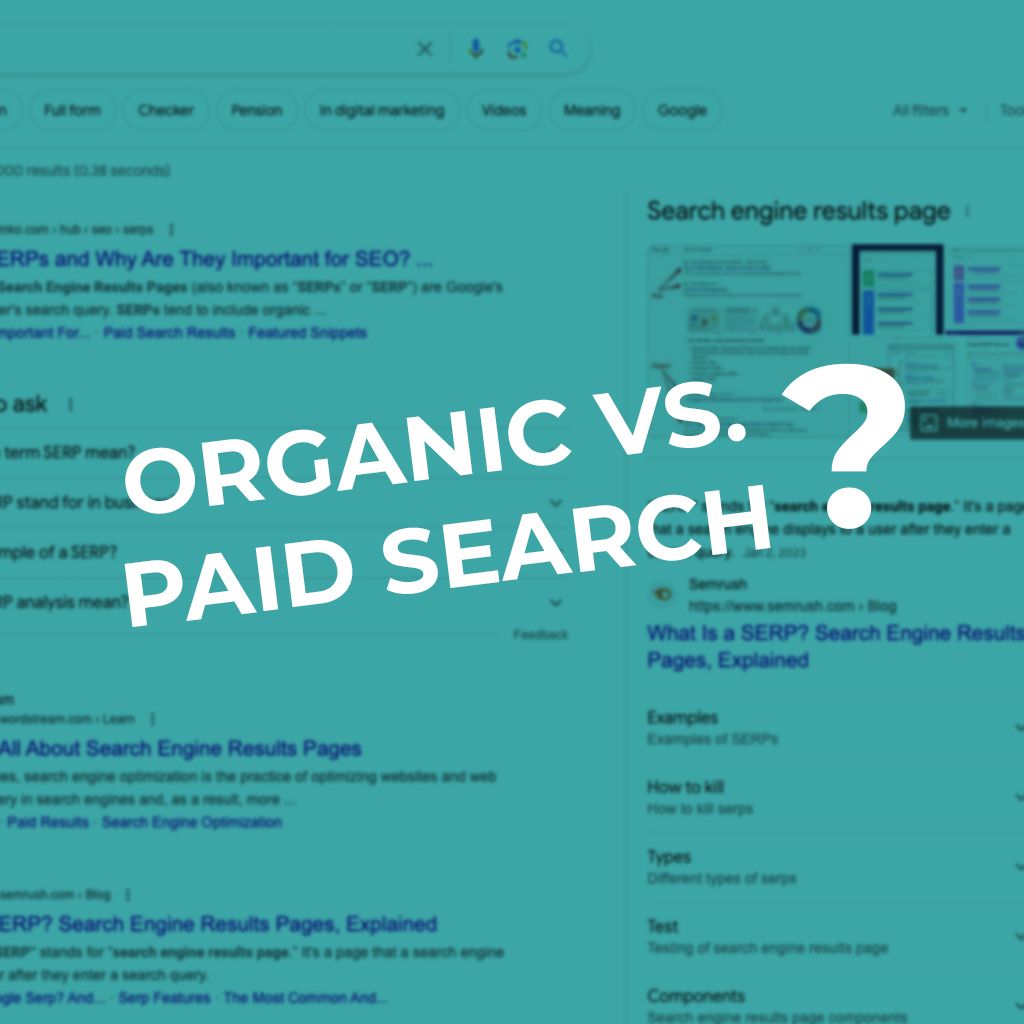Know when to optimize for organic traffic and when to pay for search results by learning the advantages and outcomes of each tactic. All website owners want to improve their rankings on search engine results pages (SERPs), but not everyone should go about this the same way. Let’s take a look at the benefits of organic search engine optimization (SEO) and paid search so you can get the most out of your marketing efforts.

What Are Organic Search Results?
An organic search result is a listing displayed on the SERP because of its relevance to a user’s query. The ranking the listing earns—meaning where on the results list it shows—depends on how well the page answers the query and Google’s algorithm.
Improving a listing’s position in the SERP requires the page to be optimized to meet ranking factors, including:
- Keywords matching the query
- Relevance and quality of the content
- Performance of the page
- Expertise and authority of the website
- The searcher’s location in relation to the business address (for local searches)
Types of Organic Search Results
Standard organic search results display as text and include a page description and a link. While ranking high with a text listing is good, a featured snippet is another type of search result that can attract traffic.
When your site content offers an especially fitting answer to a user query, you may earn a featured snippet spot on the SERP. This is how Google and other search engines highlight a search result that a user may find helpful. Snippets can be displayed as a list, table, video, image, or paragraph from your website.
Another organic search result that acts similar to featured snippets but isn’t always shown at the top of the page is People Also Ask (PAA), which offers a variety of frequently asked questions and answers in an accordion-style graphic. Marketers can create content to fulfill any of these snippet types to better a site’s visibility to qualified searchers.

How Organic SEO Works
Unlike paid search, organic rankings cannot be bought but must instead be earned by outperforming others in the variables listed above. Optimizing your website can be tedious, but the results are long-lasting and the rankings cost nothing. And while SEO isn’t a set-it-and-forget-it tactic, having a solid, well-thought-out SEO strategy to begin with provides a foundation that likely won’t call for sweeping changes anytime soon.
The beauty of investing in SEO is that the results increase exponentially. Each win is compounded, leading to more gains that website owners won’t need to continually pay for. When organic SEO is deployed strategically, it follows this cycle:
- Content creation, technical updates, and optimizations enhance the user experience.
- Engagement with the site improves and repeat visits increase.
- The bump in traffic and conversions signals to search engines that the site has something to offer users.
- Search engines boost the site’s position on the SERP, improving its visibility with qualified traffic likely to convert.
- Fellow marketers are served the optimized content and link to it from their site or mention the brand on social channels.
- Search engines determine the site is an authority, thanks to the backlinks and citations, bumping it even farther up in the SERP.
- A wider audience of qualified searchers finds the site because of its improved ranking, leading to increased traffic, engagement, conversions, and links, strengthening the site’s hold at the top of the SERP.
The Benefits of Optimizing for Organic Search
- After the initial investment, it’s free
- Effective way to reach new audiences
- Attracts visitors with intent to buy or convert
- Builds brand awareness and credibility
The Disadvantages of Organic SEO
Improving a site’s on-page, off-page, and technical performance is a major undertaking. Though everyone wants to reap the benefits of organic SEO, not all are willing to do the work to get there. Knowing where to start can baffle the most diligent website owner; jump-starting a content strategy requires resources and time, and improvements can take months to materialize on the SERPs. But once you’ve put in the effort, the improvements have a compounding effect that pays dividends long after the work is through.
What Is Paid Search?
Pay-per-click (PPC) advertising, also called paid search, is a digital marketing tactic that allows websites to show at the top of the SERPs by paying for the ranking. While running a PPC ad sounds easy enough, there’s more to it than writing a check. Like organic SEO, your ad still must meet the standards of Google and other search engines.
Types of Paid Search Ads
Paid search ads will appear to searchers in two ways—as shopping images and as text. Both displays include the word “Sponsored” but the shopping ads show images, prices, and store names while the text ads include a short meta description and link to the site.

Google and Bing measure ads to assign a quality score by evaluating:
- Keyword quality and the competitiveness of the target terms
- The ad’s relevance to the keywords or query
- The user experience on the landing page
How Paid Search Works
Paid search works by allowing marketers to bid for the top spots in the SERPs rather than earning the positioning through organic SEO. Website owners determine which keywords searchers use and out-bid a competitor for the number one position, displaying the ad above the organic search results.
These campaigns are ideal for product launches or seasonal services that are too time-sensitive to allow for SEO to organically improve the ranking.
The Benefits of PPC Ads
- Ads can begin driving traffic immediately
- Real-time tracking allows for adjustments and testing
- Multiple campaigns can test calls to action, audience behavior, and images
- Appearing at the top of the SERPs improves brand visibility, clicks or not
- Using dedicated landing pages for paid search improves the user experience, transforming leads into loyal customers
The Downfalls of Paid Search
PPC ads are more challenging than many assume and require time and effort to master. Having the resources to perform keyword research, write ad copy, and monitor campaigns is vital to effective paid search campaigns. If keyword match types aren’t chosen carefully, website owners run the risk of attracting unqualified leads who have no interest in the business, and if bidding isn’t adjusted carefully, campaigns can max out a budget fast.
How To Use Organic and Paid Search Marketing Together
Deciding on the right balance of organic optimizations and paid search isn’t easy, and luckily, it isn’t an all-or-nothing choice. While we are comparing organic versus paid search here, that doesn’t mean these marketing tactics need to be deployed separately. In fact, organic and paid search can be an effective, complementary pair to get fast and lasting results.
Using a hybrid strategy provides these advantages:
- Insights gained from paid can inform new, potentially valuable terms to use for organic SEO, and vice versa.
- Applying SEO best practices to PPC landing pages improves the page strength and quality scores.
- SEO optimizations can help stabilize a page’s rank after it drops at the end of an ad campaign.
- Using both marketing tactics provides opportunities for multiple listings on one SERP.
- Marketers can achieve full funnel coverage with combined tactics.
If you’re ready to create a holistic marketing strategy that works for you right now and in the long run, contact us today. We’re leaders in search and performance marketing, offering tools and technical expertise to leverage the best of SEO and PPC to grow your audience one (qualified) click at a time.





